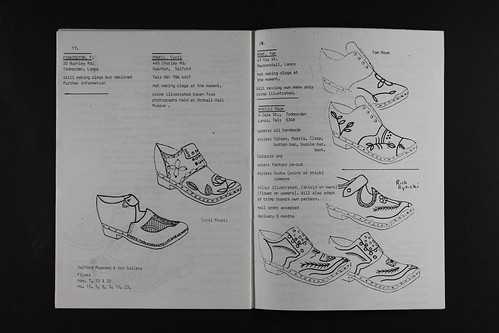My interest in folklore and cultural tradition goes back a long way. Folk Life Studies was part of my undergraduate English degree at the University of Leeds back in the 1970s and I studied part time for an MA in Folklore and Cultural Tradition about ten years ago.
My own interests have been in traditional food and calendar customs. Along the way I have been a well dresser and a ghost story teller. I have followed Pace Egg mummers plays in Calderdale and Britannia Coconut Dancers in Bacup.
I recently looked at a collection in the archive here, donated by the Manchester District branch of the English Folk Dance and Song Society (EFDSS). In among the papers, posters, scrapbooks and photographs I found a few images I could shed some light on.

To me, these children look as if they are acting out a scene from the Calderdale Pace Egg play. At first glance it looks like lads play fighting, but the boys in the background are dressed as the doctor and the old woman, characters in the Pace Egg Play. It’s difficult to put a date and location to this image. The houses are brick, whereas the houses in the area where the play is still performed are mostly built of stone. The boys are also younger than the Calder High students who perform it nowadays. I’d take a guess at late 1950s, early 1960s.

I am sure this photograph is of the Winster Guisers, a group of men who perform a guising play in the area around the Derbyshire village of Winster each Christmas. The Horse, made from a horse’s skull painted black, is very distinctive ( and quite terrifying when it clacks its jaws), as are the characters and their costumes. Again it’s hard to date, as the costumes are old fashioned and there have been several revivals, with an unbroken recent tradition since the 1980s.
It’s an unusual area of interest, and academic opportunities to study it in this country are few and far between.There’s an overlap with anthropology and social history. Folk music tends to be the focus of interest because it appeals on so many levels – for both performers and audiences. Newcastle University runs a BA course in traditional music and The University of Sheffield are planning an MA in traditional music.
Folk Dance was part of the school curriculum for many decades, thanks to work done by Cecil Sharp and others in the early twentieth century. It became a hugely popular social activity outside of schools through ceilidhs and barn dances.
Everyone is familiar with Morris dancing, but clog dancing has been a popular activity too. No ballet pumps required. A guide to clog makers in the North West is part of the archive collection.

I still have a pair of clogs made by for me by Mr Pinnington of Todmorden, and I once arranged for him to send clogs to friends in Holland. A variation on coals to Newcastle.
I’m interested in both traditional and contemporary folk music – from Shirley Collins to Chris Wood. Recently the English Folk Dance and Song Society have been publicising their huge archive digitisation project known as The Full English. They have initiated lots of radio and social media coverage.They are developing education and outreach programmes and they have also taken workshops on Folk Song in England round the country.
I recently attended one of their day courses in Sheffield.
After lively discussion about traditional songs, recording, collection, politics, contemporary research methods and interpretations, I came away from the course buzzing with ideas. Folk culture has been used and appropriated in many different ways through the centuries. Eighteenth and nineteenth century antiquarians had their Romantic notions of nationhood, while Victorian clergymen encouraged ‘pagan’ revivals of maypoles and morris dancers. Early twentieth century composers searched for origins of a definitive classical music of England. The politics of ‘Folk’ continued through the twentieth century, sometimes reinforcing the ideas of conservatism and the traditionalists, later part of a left wing protest song movement, championing of the dispossessed. As they say, ‘It’s complicated’.
The Henry Watson Music Library, based here at Central Library, holds a fantastic collection of ballads. Inherited from the Language and Literature Library, where their texts were seen as poems, they now come within the scope of the Special Collection and the Music Library. Chethams Library has been taking care of them whilst the refurbishment of Central has been going on, but soon they will be available once more.They include bawdy songs, tales of hangings, and Black Letter ballads.Some include the music, others are set ‘to the tune of…’. Some have been adapted to cover local events.It’s thought to be the best collection outside the Bodleian Library. The late Harry Boardman put together a collection, performance and CD of Manchester Ballads, and about a third of that collection came from the Henry Watson Library.
There’s a call out from the EFDSS for archive collections to identify and share information about their folk related resources. There are fourteen boxes of material from the Manchester District Branch of the EFDSS, covering a period from 1913 to 1986, in the GMCRO collection. I have tried without success to track down a representative of the donor or the local branch. If any one can help I would be grateful. There is also the ballad collection in the Henry Watson Music Library. A treasure trove worth making a song and dance about!


